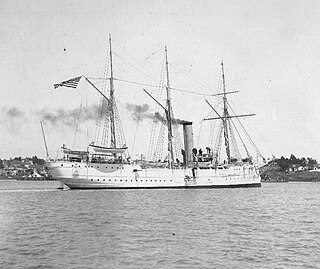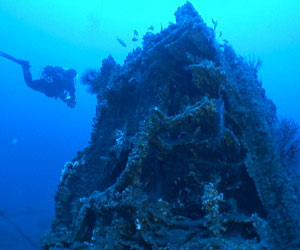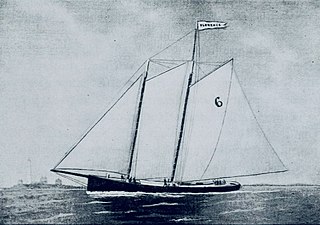
SS Yongala was a passenger steamship that was built in England in 1903 for the Adelaide Steamship Company. She sank in a cyclone off the coast of Queensland in 1911, with the loss of all 122 passengers and crew aboard.

SS Winfield Scott was a sidewheel steamer that transported passengers and cargo between San Francisco, California and Panama in the early 1850s, during the California Gold Rush. After entering a heavy fog off the coast of Southern California on the evening of December 1, 1853, the ship crashed into Middle Anacapa Island. All 450 passengers and crew survived, but the ship was lost.

The Portland Gale was a storm that struck the coast of New England on November 26 and 27, 1898. The storm formed when two low pressure areas merged off the coast of Virginia and travelled up the coast; at its peak, it produced a storm surge of about ten feet in Cohasset harbor and hurricane-force winds in Nantucket. The storm killed more than 400 people and sank more than 150 boats and ships. It also changed the course of the North River, separating the Humarock portion of Scituate, Massachusetts, from the rest of Scituate.

Stellwagen Bank National Marine Sanctuary is an 842-square-mile (638-square-nautical-mile) federally protected marine sanctuary located at the mouth of Massachusetts Bay, between Cape Cod and Cape Ann. It is known as an excellent whale watching site, and is home to many other species of marine life.

Sabino is a small wooden, coal-fired steamboat built in 1908 and located at the Mystic Seaport Museum in Mystic, Connecticut. It is one of only two surviving members of the American mosquito fleet, and it was declared a National Historic Landmark in 1992. It is America's oldest regularly operating coal-powered steamboat.

The Paul Palmer was a five-masted schooner built in 1902 by George F. Welt in Waldoboro, Maine.

USS McCulloch, previously USRC McCulloch and USCGC McCulloch, was a ship that served as a United States Revenue Cutter Service cutter from 1897 to 1915, as a United States Coast Guard Cutter from 1915 to 1917, and as a United States Navy patrol vessel in 1917. She saw combat during the Spanish–American War during the Battle of Manila Bay and patrolled off the United States West Coast during World War I. In peacetime, she saw extensive service in the waters off the U.S. West Coast. She sank in 1917 after colliding with another steamer.

Monitor National Marine Sanctuary is the site of the wreck of the USS Monitor, one of the most famous shipwrecks in U.S. history. It was designated as the country's first national marine sanctuary on January 30, 1975, and is one of only two of the sixteen national marine sanctuaries created to protect a cultural resource rather than a natural resource. The sanctuary comprises a column of water 1 nautical mile (1.9 km) in diameter extending from the ocean’s surface to the seabed around the wreck of the Civil War ironclad, which lies 16 nautical miles (30 km) south-southeast of Cape Hatteras, North Carolina. Average water depth in the sanctuary is 230 feet (70 m). Since its sinking in 1862, the Monitor has become an artificial reef attracting numerous fish species, including amberjack, black sea-bass, oyster toadfish and great barracuda.

Frank A. Palmer and Louise B. Crary are a historic dual shipwreck site in the Stellwagen Bank National Marine Sanctuary, off Gloucester, Massachusetts.
The Metropolitan Steamship Company was for 75 years one of the chief transportation links between New York City and Boston, Massachusetts. It was closely associated with the Whitney family until its acquisition by Charles W. Morse in 1906. Even after being merged into Eastern Steamship Lines, it was maintained as a distinct service, the Metropolitan Line, until 1941.

The Edna G is a shipwrecked eastern rig dragger located on the seafloor of the Atlantic Ocean in the Stellwagen Bank National Marine Sanctuary. Laid down at Morehead City, North Carolina in 1956, she was a wooden-hulled, engine-powered vessel. She fished off the North Carolina coast until 1972, and then out of Portland, Maine until 1977, when she was moved to Gloucester, Massachusetts. She sank due to unknown causes in June 1988. The wreck was located in 2003. Due to its relatively pristine condition, the wreck has been listed on the United States National Register of Historic Places as an exemplar of mid-20th century fishing technology.
SS United States was a merchant steamship launched in 1864 and lost off Cape Romain, South Carolina, in 1881. She was the most expensive steamer built by the American shipbuilding firm of S. Gildersleeve & Son, which built 120 vessels. The vessel was named for her country and sported the United States' national symbol, an American eagle, as her figurehead.

The Lamartine is a 19th-century shipwreck lying in the waters of the Stellwagen Bank National Marine Sanctuary, off Gloucester, Massachusetts. She was a schooner built in 1848 in Camden, Maine. She was hauling quarried granite from Stonington, Maine to New York City when she went down in a storm on May 17, 1893. One crewmember drowned; the others were rescued by a fishing vessel that saw the ship sinking. The wreck was located in 2004 by a survey team, documented over the next two years.

The Joffre is a 20th-century shipwreck lying in the waters of the Stellwagen Bank National Marine Sanctuary, off Gloucester, Massachusetts. She was a schooner built in 1912 in Essex, Massachusetts. Active in the Gloucester fishery, she first used tub trawls for fishing, and was converted to an eastern rig dragger and motorized in 1939. She was returning to Gloucester when her engine caught fire on the evening of August 9, 1947. The wheelhouse was engulfed, the crew abandoned ship, and she sank the next day. The wreck was documented by a Stellwagen Bank survey team in 2006.

The SS City of Chester was a steamship built in 1875 that sank after a collision in a dense fog with SS Oceanic at the Golden Gate in San Francisco Bay on August 22, 1888. She was owned by the Oregon Railroad Co. and leased by the Pacific Coast Steamship Company.
The following index is provided as an overview of and topical guide to Wikipedia's articles on recreational dive sites. The level of coverage may vary:

The SS Atlanta was a wooden hulled Great Lakes steamer that sank in Lake Michigan off the coast of Cedar Grove, Wisconsin, United States, after a failed attempt of her being towed to shore ultimately killing 5 out of her 7 crew members on board. Her wreckage still remains at the bottom of the lake, and on November 6, 2017, the wreck of the Atlanta was listed on the National Register of Historic Places.

Recreational dive sites are specific places that recreational scuba divers go to enjoy the underwater environment or for training purposes. They include technical diving sites beyond the range generally accepted for recreational diving. In this context all diving done for recreational purposes is included. Professional diving tends to be done where the job is, and with the exception of diver training and leading groups of recreational divers, does not generally occur at specific sites chosen for their easy access, pleasant conditions or interesting features.

Florence was a 19th-century Boston pilot boat built in 1867 from a model by Dennison J. Lawlor for William C. Fowler. The vessel had a reputation for being fast under sail. She had a long career in the Boston service, skippered by many famous pilots. She was the oldest pilot-boat in the service. In 1897, she was sold to a Portland, Maine group for fishing and yachting excursions. The pilot boat America, No. 1, was launched on April 19, 1897, to replace the Florence.




















